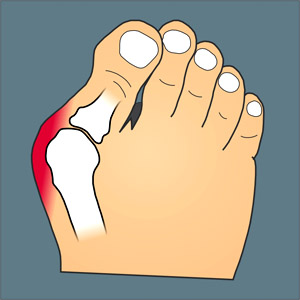Table of Contents
Bunions: what are they?
A bunion is formed when the tissue of the big toe becomes swollen forming a big bony bump on the flank of the foot. Often, there is also thickening of the skin and soft tissue next to the affected joint. Bunions can be intensely painful and can even lead to arthritis.

Source: Wikimedia.org
Most shoes cannot accommodate the resulting protrusion and will put additional pressure on the already misaligned joint. The result is a fluid-filled sac (bursa) which develops over the joint. The bursa finally becomes inflamed, stiff and painful.
A bunion is most likely to grow when vulnerable feet are frequently squeezed into constricted, pointed-toe shoes. While shoes with narrow toes can cause a bunion (check the best shoes for bunions), they are not the primary reason. Bunions run in families because genes define factors such as foot type and structure. Aspects that also seem to increase the risk are:
- Flat feet
- Loose feet and tendons
- Low arches
- The shape of the metatarsal head
- If it is too round, the joint is not firm and is more probable to deform when squeezed into sharp pointed shoes.
- High heels
- High heels aggravate the problem because they tend to tip the weight of body forward forcing the toes into the narrow front part. This may be the main reason why bunions are more common in women than men.
- Occupational hazard
- Individuals in occupations that include a lot of standing and walking such as teachers and nurses are more vulnerable to bunions. Also, included are ballet dancers whose feet undergo severe stress and pressure.
- Hormonal changes
- Pregnant women are at increased risk of developing bunions and other feet difficulties since hormonal alterations slacken the tendons and flatten the feet.
Bunion exercises that may help
Interventions that exclude surgery such as physical therapy and bunion correctors can slow the progression of bunions. These strategies are best, to begin with before involving surgery. Here are exercises that could benefit people who have bunions.
1. Toe stretching
Stretching the toes help keep them flexible and ease the pain. To stretch the toes, point them straight ahead for up to 5 seconds, then curl them for the same amount of time. Repeat this stretching ten times.
2. Stretching the big toe
Use the fingers to slowly and gently pull the big toe into proper position for 10 seconds. Repeat 3-4 times.
3. Traction
Traction has proved beneficial to people with spinal problems and can be employed to keep the big toe mobile. Take hold of the toe and act as if you want to “pull it off”. Hold in this position for up to 15 seconds. This can be repeated several times. For persons who suffer from arthritis or are elderly, professional advice should be sought before beginning this exercise.
4. Resistance exercises
Furthermore, resistance exercises are further recommended. This is achieved by wrapping a belt or towel around the big toe. Use the the belt or towel to pull the big toe towards you as you simultaneously push forward against the belt or towel with the big toe.
5. Take walks along the beach
Spend some time walking on the beach. The sand will massage the feet gently and help to give strength to the toes. This is recommended for people whose unions bunions are a result of arthritis.
6. The ball roll
Place a small round ball on the floor beneath the feet as while seated. Turn it around with the foot for 2 minutes. This aids in the relief of cramping and foot strain.
7. Picking marbles
Place 20 marbles on a flat surface. Pick them out of the floor and into a bowl one by one using your foot. The gripping exercise is excellent for the feet and will help improve mobility and flexibility.
8. Curling with towels
To do this, spread a towel on a flat surface beneath you. Curl your toes gently around it and try to pull it towards you. Repeat up to 5 times. This gripping exercise can help strengthen your feet.
9. Flexing and contracting the toes
Place the toes on a flat, hard surface like a wall. Flex while stretching them for a while. Hold for 10 seconds and replicate 3 to 4 times. Bend your toes in opposite direction and hold for ten another 10 seconds. Repeat up to 4 times.
Other helpful tips
- Do not wear tight, high heeled pointed shoes.
- Wear shoes that are roomy (you can use shoe stretcher) and that fit your feet well.
- A padding on the bunion may be helpful. Ice may be useful too.
- Shoes that have straps or laces may be best as you can adjust them accordingly.
Bunions afflict many women across all races and ages. They can however be managed. The victims can have relief from pain and greatly benefit from foot bunion exercises.




